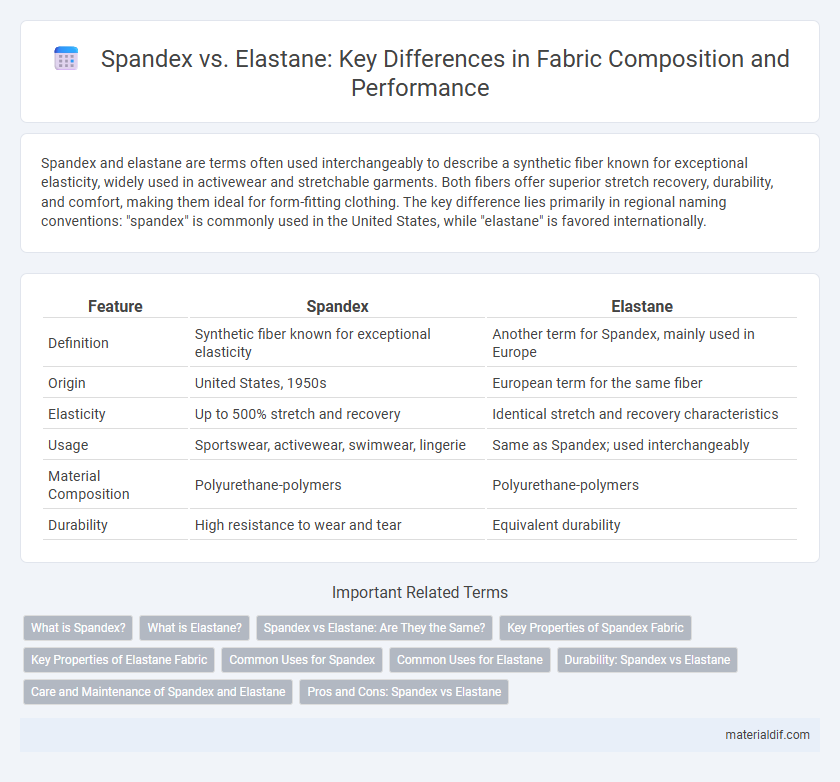Spandex and elastane are terms often used interchangeably to describe a synthetic fiber known for exceptional elasticity, widely used in activewear and stretchable garments. Both fibers offer superior stretch recovery, durability, and comfort, making them ideal for form-fitting clothing. The key difference lies primarily in regional naming conventions: "spandex" is commonly used in the United States, while "elastane" is favored internationally.
Table of Comparison
| Feature | Spandex | Elastane |
|---|---|---|
| Definition | Synthetic fiber known for exceptional elasticity | Another term for Spandex, mainly used in Europe |
| Origin | United States, 1950s | European term for the same fiber |
| Elasticity | Up to 500% stretch and recovery | Identical stretch and recovery characteristics |
| Usage | Sportswear, activewear, swimwear, lingerie | Same as Spandex; used interchangeably |
| Material Composition | Polyurethane-polymers | Polyurethane-polymers |
| Durability | High resistance to wear and tear | Equivalent durability |
What is Spandex?
Spandex is a synthetic fiber known for its exceptional elasticity, commonly used in activewear, swimwear, and form-fitting clothing. It can stretch up to five times its original length, providing comfort and freedom of movement while retaining its shape. Spandex is often synonymous with elastane, but the term "spandex" is primarily used in the United States, whereas "elastane" is more common internationally.
What is Elastane?
Elastane is a synthetic fiber known for its exceptional elasticity, commonly used in activewear, swimwear, and underwear to provide superior stretch and comfort. It is a type of polyurethane-polyurea copolymer, often marketed under brand names like Lycra or Spandex, though elastane is the generic term primarily used outside the United States. This fabric enhances garment durability and shape retention while allowing for improved mobility and fit in various clothing applications.
Spandex vs Elastane: Are They the Same?
Spandex and elastane refer to the same synthetic fiber known for exceptional stretch and recovery properties, widely used in activewear, swimwear, and hosiery. The term "spandex" is predominantly used in the United States, while "elastane" is the preferred nomenclature in Europe and other regions. Both fabrics consist of polyurethane-polyurea copolymers, offering flexibility, comfort, and durability with comparable performance characteristics.
Key Properties of Spandex Fabric
Spandex fabric, known for its exceptional elasticity, can stretch up to five times its original length while maintaining shape retention, making it ideal for activewear and performance clothing. Its lightweight and moisture-wicking properties enhance comfort and breathability during physical activities. High durability and resistance to sweat, oils, and lotions ensure longevity and consistent performance in demanding conditions.
Key Properties of Elastane Fabric
Elastane fabric is renowned for its exceptional elasticity, often stretching up to 500% of its original length, which makes it highly durable and resistant to wear and tear. Its lightweight and moisture-wicking properties provide superior comfort and breathability in activewear and performance clothing. Elastane retains shape and flexibility even after multiple washes, making it ideal for tight-fitting garments and sportswear.
Common Uses for Spandex
Spandex is widely used in activewear, swimwear, and underwear due to its exceptional stretch and recovery properties. It enhances comfort and fit in garments such as leggings, sports bras, and compression clothing, making it ideal for physical activities. The fabric's durability and resistance to body oils and perspiration contribute to its popularity in performance and casual apparel.
Common Uses for Elastane
Elastane, known for its exceptional stretch and recovery properties, is commonly used in activewear, swimwear, and leggings to provide comfort and flexibility. Its moisture-wicking capabilities make it ideal for performance fabrics in sports apparel and fitness garments. Elastane blends with cotton or polyester enhance mobility and durability, making it a staple in casual and athleisure clothing.
Durability: Spandex vs Elastane
Spandex and elastane are often used interchangeably, but both offer exceptional durability due to their ability to withstand repeated stretching without losing shape. Spandex fibers demonstrate high resistance to wear, making fabrics resilient to pilling and tears even after extensive use. Elastane enhances fabric flexibility while maintaining durability, which is essential for activewear and performance textiles requiring long-lasting elasticity.
Care and Maintenance of Spandex and Elastane
Spandex and elastane fabrics require gentle care to maintain their elasticity and durability, best preserved by washing in cold water with mild detergents. Avoiding high heat during drying and ironing prevents fiber damage, as both materials are sensitive to heat. Proper care extends the lifespan of garments, retaining their stretch and shape for optimal performance.
Pros and Cons: Spandex vs Elastane
Spandex and elastane are often used interchangeably, but spandex typically refers to the fiber predominantly used in the US, while elastane is the term more common in Europe; both offer exceptional stretch and shape retention, making them ideal for activewear and form-fitting garments. Spandex tends to be more durable and resistant to heat and sweat, but can be less breathable, whereas elastane blends tend to incorporate better moisture-wicking properties for comfort. The primary drawback of both fibers includes sensitivity to chlorine and prolonged exposure to high temperatures, which can degrade elasticity over time.
Spandex vs Elastane Infographic

 materialdif.com
materialdif.com